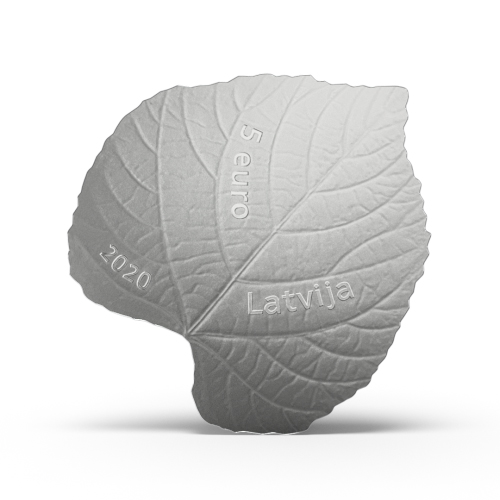
E-mail: coins@bank.lv
Cashier's Office in Riga
Address: Bezdelīgu 3, Rīga
Phone: +371 67022722
 Kolekcijas
KolekcijasSelect your language


Obverse
The coin has the shape of a linden leaf, and its obverse features a leaf venation pattern. The inscription "5 euro" is placed slantwise in a semicircle in the middle to the left of the line joining the base with the tip of the leaf, the year 2020 – at the bottom, but the inscription "Latvija" – in the middle to the right of the line.
Reverse
The network of Riga streets symbolically depicts the leaf venation.
Edge
Plain.
Specifications
Face value: 5 euro
Weight: 18.13 g
shape: irregular; distance from the base of the leaf to the tip: 32.00 mm
Metal: silver of fineness .925
Quality: proof
Maximum mintage: 5 000
Struck in 2020 by Koninklijke Nederlandse Munt (The Netherlands))
Artists Graphic design: Mārcis Kalniņš
Plaster model: Ligita Franckeviča
In the past half century, the changes in our environment had been considerable and unprecedented. With greater numbers of people moving to urban areas, we have to ensure that cities are as attractive and livable as possible without destroying the planet. A sustainable city is the answer if we understand the meaning of the idea correctly and know how to implement this concept, which encompasses all the environmental issues concerning the urban and suburban environment, the inclusion of their solutions in territorial policies to limit or repair environmental impacts. The final result should improve the urban environment and the quality of life of residents. So sustainable means in balance with the environment.
Cities are made of different urban components: streets, buildings, water and green areas. All of them have a role to play in people's lives in terms of housing, commercial areas, educational and cultural institutions, entertainment and recreation areas, etc. The provision of core functions is essential, but the well-being and health of inhabitants should also be taken into consideration. To be able to breathe properly in a city is a crucial test to verify its sustainability. Cities are increasingly struggling with providing for this simple basic need. Unlike other big cities, Riga is quite a green one. This quality is becoming more essential with more urban development. Green areas improve the microclimate since they purify the air and water, thus improving human health, and provide natural habitat for animals and insects. They are both a cultural heritage and part of an easy economical solution to reduce the human impact on the environment.
The network of Riga streets has been designed for people, connecting them with places in the urban environment, the same as the veins in a leaf transporting substances throughout the leaf tissues. All of it makes a whole. The linden tree is one of the most common and resistant trees you can find in Riga. This tree, which lives up to 200–300 years and has seen many generations change, also represents one of the most precious resources of the city. The wind-resistant, shade and climate tolerant linden trees capture large amounts of dust and give city dwellers clean air in return. Nowadays, this common and simple component of nature has to be appreciated and cherished. Urban nature is extremely beneficial but also critically vulnerable. This is the balance humans have to strike to preserve their urban environment livable.
Living in a clean and pleasant city for generations is a simple need and a right we have. Moreover, there is a solution we can all implement in an easy and efficient way since each individual's actions affect our common environment. They might seem irrelevant and insignificant, but a multitude of small actions make great impacts. The way we consume, the way we produce, the way we decide how to live our lives shapes our future. The city is not only made of streets, buildings and green areas. We are a definitive part of this environment in balance that we need to maintain and appreciate as our natural heritage, while also respecting nature as a space for the human soul.
The collector coin dedicated to ecology was developed as an environment-friendly project: recycled silver was used for minting, and recycled paper was used for producing its packaging and informational materials.
